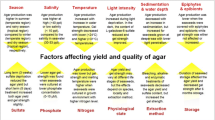Abstract
Phosphate concentration of the growth medium was found to affect the growth rate and agar yield of a clone of Gelidium robustum grown in the laboratory. To study differences in growth we used phosphate concentrations from 0 to 200 µM. To determine the effect of phosphate on agar yield and its properties we used concentrations from 0 to 20 µM. Growth rates generally increased with increasing phosphate concentration, with the highest growth rate (21% d−1) obtained at 150 µM. Agar yield as percentage of fresh weight was highest (10%) in the algae grown with low phosphate concentrations, but agar yield as percentage of dry weight was highest(43%) at 20 µM of phosphate. Gel strength increased with phosphate concentration with a maximum of 160 g m−2 for 0.75% gels for the cultures at 20 µM. Melting and gelling temperatures of the gels were also affected by phosphate concentration of the growth medium. Starch yield was highest in algae grown in low phosphate concentrations.
Similar content being viewed by others
References
Bird, K. T., M. D. Hanisak & J. Ryther, 1981. Chemical quality and production of agar extracted from Gracilaria tikvahiae grown in different nitrogen enrichment conditions. Bot. mar. 24: 441–444.
Carter A. R. & R. J. Anderson, 1986. Seasonal growth and agar contents in Gelidium pristoides (Gelidiales, Rhodophyta) from Port Alfred, South Africa. Bot. mar. 29: 117–123.
Chiles, T. C., K. T. Bird, & F. E. Koehn, 1989. Influence of nitrogen availability on agar-polysaccharides from Gracilaria verrucosa strain G-16: structural analysis by NMR spectroscopy. J. appl. Phycol. 1: 53–58.
Chopin, T. M., D. Hanisak & F. E. Koehn 1991. Effects of seawater phosphorus concentration on floridean starch content in Agardhiella subulata (C. Agardh) Kraft et Eynne (Rhodophyceae). Bot. mar. 34: 369–373.
Chopin, T. M. D. Hanisak, F. E. Koehn, J. Mollion & S. Moreau, 1990. Studies of carrageenan content and growth of Agardhiella subulata (C. Agardh) Kraft et Eynne (Rhodophyceae, Solieriaceae). J. appl. Phycol. 2: 3–16.
Craigie, J. S. & C. Leigh, 1978. Carrageenans and agars. In Hellebust, J. A. & J. S. Craigie (eds.) Handbook of phycological methods: physiological and biochemical methods. Cambridge University Press, Cambridge, U. K.: 110–131.
Ekman, P., A. Lignell & M. Pedersen, 1989. Localization of ribulose-1,5-biphosphate carboxylase/oxygenase in Gracilaria secundata (Rhodophyta) and its role as a nitrogen storage pool. Bot. mar. 32: 527–534.
Ekman, P., S. Yu & M. Pedersen, 1991. Effect of altered salinity, darkness and algal nutrient status on floridoside and starch content, δ- Galactosidase activity and agar yield of cultivated Gracilaria sordida. Br. phycol. J. 26: 123–131.
Friedlander, M. & A. Ben-Amotz, 1991. The effect of outdoor culture conditions on growth and epiphytes of Gracilaria conferta. Aquat. Bot. 39: 315–333.
Lahaye, M. & W. Yaphe, 1991. Chemical structure and physicochemical properties of agar. Hydrobiologia 221: 137–148.
Lapointe, B. E., 1985. Strategies for pulsed nutrient supply to Gracilaria cultures in the Florida Keys: interaction between concentration and frequency of nutrient pulses. J. exp. mar. Biol. Ecol. 93: 211–222.
Lapointe, B. E., 1987. Phosphorus- and nitrogen -limited photosynthesis and growth of Gracilaria tikvahiae (Rhodophyceae) in the Florida Keys: an experimental field study Mar. Biol. 93: 561–568.
Littler, M. M. & S. N. Murray, 1975. Impact of sewage on distribution, abundance and community structure of rocky intertidal macroorganisms. Mar. Biol. 30: 277–292.
Macler, B. A., 1986. Regulation of carbon flow by nitrogen and light in the red alga, Gelidium coulteri. Plant Physiol 82: 136–141.
Macler, B. A. & J. A. West, 1987. Life history and physiology of the red alga Gelidium coulteri in unialgal culture. Aquaculture 61: 281–293.
McLachlan, J., 1973. Growth media -marine. In Stein, J. R. (ed.) Handbook of phycological methods — culture methods and growth measurements. Cambridge University Press, Cambridge, U. K.: 25–52.
Rincones, R. E., S. Yu & M. Pedersen, 1993. Effect of dark treatment on starch degradation and the agar quality of cultivated Gracilariopsis lemaneiformis (Rhodophyta, Gracilariales) from Venezuela. Hydrobiologia 260/261: 633–640.
Santelices, B., 1988. Synopsis of biological data on the seaweed genera Gelidium and Pterocladia (Rhodophyta). FAO Fisheries Synopsis 145: 1–55.
Author information
Authors and Affiliations
Rights and permissions
About this article
Cite this article
Sousa-Pinto, I., Lewis, R. & Polne-Füller, M. The effect of phosphate concentration on growth and agar content of Gelidium robustum (Gelidiaceae, Rhodophyta) in culture. Hydrobiologia 326, 437–443 (1996). https://doi.org/10.1007/BF00047843
Issue Date:
DOI: https://doi.org/10.1007/BF00047843




